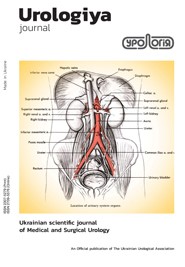Evaluation of the activity of energy and biosynthetic processes as a screening for the course of acute experimental pyelonephritis under the influence of pharmacological monitoring
DOI:
https://doi.org/10.26641/2307-5279.27.1-2.2023.291278Keywords:
acute pyelonephritis, diabetes mellitus, course, biosynthetic processes, drug effect, diabetic nephropathyAbstract
In the aspect of studying the prerequisites for the development of diabetic nephropathy, it seems appropriate to study in depth individual enzyme systems that are directly related to the respiratory chain of mitochondria, the implementation of endothelial functions, and biosynthetic processes. Nicotinamide adenine dinucleotide (NAD) has key functions: it is an important coenzyme in the electron transfer reaction and a coenzyme for NAD-dependent enzymes. The role of NAD in electron transfer reactions is significant, since more than 400 enzymes require NAD and nicotine amide adenine dinucleotide phosphate (NADP), mainly to accept or donate electrons for redox reactions, that is, energy reactions in mitochondria and biosynthetic processes. The aim of the study was to study the role of pyridine nucleotides in the pathogenesis of acute pyelonephritis (AP) and concomitant diabetes mellitus in an experiment with the use of drug exposure. It has been established that the use of etiotropic-pathogenetic drug effect (EPDE) in comparison with etiotropic drug effect (EDE) creates a pronounced normalizing effect on the level and ratio of the forms of the coenzyme system NAD / NADH and NADP / NADPH, contributing to a decrease in the level of the reduced form of NAD increased in AP and type I diabetes and an increase in the content of NADPH in the kidneys, as well as decrease in the level of NADP and NADPH in AP and type II diabetes by 17.9% and 36.3%, The results of experimental biochemical studies obtained by us convincingly prove the expediency of the clinical use of EPDE in order to increase the effectiveness of the corrective effect on pathological changes and prevent the complicated course of diabetic nephropathy.
References
Ronald, A., & Ludwig, E. (2001). Urinary tract infections in adults with diabetes. Int J Antimicrob Agents, 17, 287-292. https://doi.org/10.1016/S0924-8579(00)00356-3
Hirji, I., Guo, Z., Andersson, S. W., Hammar, N, & Gomez-Caminero, A. (2012). Incidence of urinary tract infection among patients with type 2 diabetes in the UK General Practice Research Database (GPRD). J Diabetes Complications, 26, 513-516. https://doi.org/10.1016/j.jdiacomp.2012.06.008
Manischenkova, Yu. A., Shkala, L. V., Dudich, T. I., Litvinova, M. I., & Ivanova, M. A. (2013 Oksidantnyi stress u bolnykh s sakharnym diabetom 2-go tipa, sochetannym s obostreniem khro¬niches¬kogo piyelonefrita [Oxidative stress in patients with diabetes mellitus type 2 associated with exa-cerbation of chronic pyelonephritis]. Mezhdu-narodnyi endokrinologicheskii zhurnal, 51(3), 19.
https://doi.org/10.22141/2224-0721.3.51.2013.84311
Forbes, J. M., & Thorburn, D. R. (2018). Mito-chondrial dysfunction in diabetic kidney disease. Nat Rev Nephrol, 14, 291-312. https://doi.org/10.1038/nrneph.2018.9
Ralto, K. M., Rhee, E. P., & Parikh, S. M. (2020). NAD+ homeostasis in renal health and disease. Nat Rev Nephrol, 16, 99-111. https://doi.org/10.1038/s41581-019-0216-6
Mahtal, N, Lenoir, O. & Tharaux, P-L. (2021). Glo¬merular endothelial cell crosstalk with podocytes in diabetic kidney disease. Front. Med., 8, 659013. https://doi.org/10.3389/fmed.2021.659013
Kurskyi, M. T. S., & Korzhenko, O. M. (2010). Rehulyuvannya aktyvnosti fermentiv [Regulation of enzyme activity], Visnyk problem biolohiyi ta medytsyny, 1, 30-40.
Wolf, D. H., & Menssen, R. (2018). Mechanisms of cell regulation – proteolysis, the big surprise. FEBS Letters, 592, 2515-2524. https://doi.org/10.1002/1873-3468.13109
Amjad, S., Nisar, S., Bhat, A. A., Shah, A. R., Frenneaux, M. P., Fakhro, K., … Bagga, P. (2021). Role of NAD+ in regulating cellular and metabolic signaling pathways. Mol. Metab., 49, 101195. https://doi.org/10.1016/j.molmet.2021.101195
Line Agledal, Marc Niere, & Mathias Ziegler. (2010). The phosphate makes a difference: cellular functions of NADP. Redox Report, 15(1), 2-10. https://doi.org/10.1179/174329210X12650506623122
Dhruv, K. Singh, Peter Winocour, & Ken Farrington. (2011). Oxidative stress in early diabetic nephropathy: fueling the fire. Nature Reviews Endo¬cri¬nology, 7(3), 76-84. https://doi.org/10.1038/nrendo.2010.212
Yan, L.-J. (2021). NADH/NAD+ redox imbalance and diabetic kidney disease. Biomolecules, 11, 730. https://doi.org/10.3390/ biom11050730
Bairasheva, V. K. (2015). Modelirovanie sakharnogo diabeta i diabeticheskoi nefropatii v eksperimente [Experimental modeling of diabetes mellitus and diabetic nephropathy]. Sovremennye problemy nauki i obrazovaniia, 4. Retrieved from: https://www.science-education.ru/ru/article/view.id=21024
Zhang Ming, Xiao-Yan, Lv Jing Li, Zhi-Gang Xu, & Li Chen. (2008). The characterization of high – fat diet and multiple low – dose streptozotocin induced type 2 diabetes rat model. Exp. Diabetes Res, 2008, Article ID 704045, 9. https://doi.org/10.1155/2008/704045
Downloads
Published
Issue
Section
License
Стаття повинна мати візу керівника та офіційне направлення від установи, з якої виходить стаття (з круглою печаткою), і вказівкою, чи є стаття дисертаційною, а також у довільній формі на окремому аркуші - відомості про авторів (прізвище, ім’я, по батькові, посада, вчений ступінь, місце роботи, адреса, контактні телефони, E-mail).
Стаття повина бути підписана всіма авторами, які укладають з редакцією договір пропередачу авторських прав (заповнюється на кожного автора окремо з оригінальним підписом). За таких умов редакція має право на її публікацію та розміщення на сайті видавництва.

